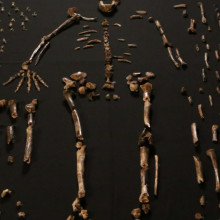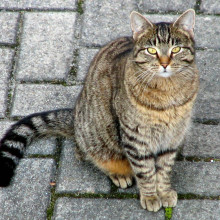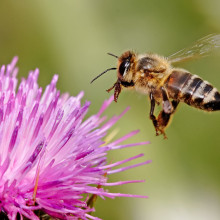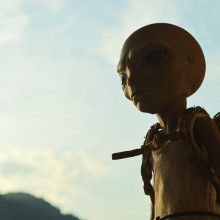Would Aliens Understand Maths?
Love it or loathe it maths is everywhere... from counting bees to interstellar trade with aliens, we explore how maths earned the title of the language of the universe. Plus, getting to know our new ancestor Homo naledi, how a good night's sleep can help to ease your pain and why the cat who got the cream shouldn't be quite so happy.
In this episode

00:51 - How old is Homo naledi?
How old is Homo naledi?
with Professor Lee Berger, University of the Witwatersrand and Professor John Hawks, University of Wisconsin-Madison
Back in September 2015, a new species of early human - Homo naledi - was announced to the world. The remains were found in the aptly named ‘Cradle of Humankind’ near Johannesburg, South Africa at the Rising Star cave system. Since their discovery they have changed the way that we think about human evolution. Now another chamber has been discovered containing yet more remains and analysis of the skeletons within has shed light on what Homo naledi looked like and where they fit into the timeline of evolution. Tom Crawford spoke to the lead researchers…
Lee - I’m Professor Lee Berger; I’m a research professor at the University of Witwatersrand in Johannesburg, South Africa and Explorer in Residence at the National Geographic.
We’ve discovered first a new chamber with more Homo Naledi about 100 metres from the original chamber - it’s called the Lesedi chamber. It’s got multiple individuals in it including a partial skeleton of Homo Naledi, an adult male we call Neo, which means ‘gift’ by the way. It’s not after the matrix character. We also have finally dated Homo naledi for the Dinaledi chamber; the fossils that we announced in September, 2015. And, contrary to what I think practically, every scientist who had seen or studied the remains thought these individuals are not millions of years old as they probably should have been by their anatomy, but they are relatively young, between 2 and 300,000 years approximately. That places them in the presence, potentially, of modern humans who we believe are evolving in Southern Africa at that time and certainly, we’ve seen first what we used to think of as the first archaeological evidence of modern human behaviour.
Tom - Homo naledi: is this some sort of primitive human species in some sense?
John - Yeah, exactly right. I’m John Hawks and I’m a Professor of Anthropology at the University of Wisconsin, Madison and at Vitz University in South Africa.
When we look at Homo naledi, and we have a better skeletal record now of naledi now than we do of any other fossil hominin except for the Neanderthals and modern humans. So we know a lot about it and its human-like in some aspects. It’s human-like in its hands and wrists in many ways, in its feet. It's human-like in body size and it’s got very small human-like teeth which indicates something about its diet.
But much of the rest of the skeleton is very primitive. It has a brain about a third the size of modern human brains. It has a very primitive early homo-like skull and parts of the trunk are very primitive also, so it has this mixture of characteristics. It’s been very difficult for us to try to figure out exactly how it’s connected to us but it’s clear that its origin, its branching from our evolution, has to be something like 2 million years ago, so that’s where people were thinking it would be.
Tom - But you’ve now shown that it’s much more recent than that?
John - Exactly right. That lineage may have originated two million years ago - it looks like it. But this population existed in the very recent past - 200, 300,000 years ago. So it shows that there was a lineage that lasted up to two million years that was in Africa evolving at the same time that our ancestors and, potentially, and other lineages of archaic humans are evolving. It’s a very complicated scenario, and even five or ten years ago we would have said this is probably a very simple scenario. So this has really shocked us and shocked many in the field.
Tom - You mentioned this was a new cave that you’ve discovered. So was this branching off from the old cave system?
John - The Rising Star system as a whole has up to two kilometres of passageways underground that we’ve got mapped. Now our first discovery, the Dinaledi chamber was not on the map and it was a very difficult descent down into it and very surprising that we found bones lying on the surface. As we were excavating that, our exploration team said I think I’ve seen something like this somewhere else, and the original two discoverers of the Dinaledi chamber, Steve Tucker and Rick Hunter showed us the Lesedi chamber and it also had skeletal material on the surface. It wasn’t as obvious and it had been missed before but we began to explore that, we began to do very limited skeletal excavations in it and preserved some of the best Homo naledi remains.
Lee - What’s also fascinating is that the Lesedi chamber which, by the way, means 'chamber of light', is almost as difficult to get to as the Dinaledi chamber, the original chamber. It’s not quite as difficult, the squeeze is only about 25cms instead of a terrible 18cms, and I can attest to the difficult because I’ve been in it once and almost didn’t get out of it. I was stuck for almost an hour before they had to pull me out. But there it’s clear that Homo naledi was choosing to go into these very similar, very difficult to access chambers, generally 30 metres or so underground. That is a really remarkable to think the journey that they would have taken to get to these two places and why they would have done that?
Tom - That is my next question then, why do we think they may have been going into these chambers?
John - We know that we find their bodies, and bodies of individuals of all ages. In the Dinaledi chamber, at least 15 individual, newborns to old adults. In the Lesedi chamber we have at least three individuals, two adults and one juvenile, potentially more. So we know they’re leaving their bodies there.
What we don’t know is how they may have been using other parts of the cave system. We are now turning to investigate that by excavating probably nearer to the surface where we use and also by looking systematically for other evidence of naledi behaviour inside the cave. In particular, we’re super interested in the possibility that there will be evidence of fire somewhere in the cave.
Lee - So we went to initially a great deal of effort to try and explain any other reason that Homo naledi might be using these chambers except for ritualised, deliberate body disposal, which a lot of people just didn’t like. Several scientists wrote a couple of articles, which we responded to, and say a small-brained hominid can’t do it, but that’s about the only argument there is against that idea - just not liking it. That one of things we see as precious has been intruded on by a hominid with the brain the size of an orange.
Finding a second Lasedi chamber that is practically identical in its formation, its location, its position, and contents to the first chamber I personally think adds quite a lot of evidence to the idea that Homo naledi really was ritually disposing of its dead.

07:30 - Lack of sleep may worsen chronic pain
Lack of sleep may worsen chronic pain
with Alban Latremoliere, Boston Children's Hospital
We all feel the benefits of a decent night’s sleep, but could not getting enough kip be making life more painful? New research from a team at Boston Children’s Hospital and Beth Israel Deaconess Medical Centre has shed light on the link between lack of sleep and sensitivity to pain. But What might this mean for the millions of people in the UK and around the world that suffer from chronic pain? Surprisingly, it seems that a good old cup of coffee might help! Katie Haylor spoke to pain scientist and study co-author Alban Latremoliere...
Alban - We wanted to understand the possible relationship between lack of sleep and pain sensitivity. To measure that using human subjects is extremely complicated so we used animal models for which we have very little genetic variation and we can control the environments. That way we could precisely assess both their sleep/wake patterns and their pain sensitivity. We then exposed those animals to different sleep disturbances chronically to see how much it affected their pain level.
Katie - So this is the equivalent of a human having a late night, maybe going out a bit too much or watching too much telly, something like that?
Alban - That was the goal we had in mind. The mouse would make the same mistake we’re doing.
Katie - Presumably mice don’t watch box sets; how do you entertain a mouse?
Alban - It turns out that mice love chewing. I guess it comes with the fact they are a rodent and actually that makes them happy. Another thing we found mice love is cotton and so we tried to come up with strategies where mice would have to be curious and chew on some material to reach some nice cotton ball inside, and that would motivate them to stay awake. They can spend 30 minutes just having fun with them so it was actually very cute to watch.
Katie - Just at the point at which they’re wanting to go to sleep you’re going - hey, play with this cool thing and that’s the way that you chronically deprive them of sleep?
Alban - Exactly.
Katie - And you want to see if there is a link between how sleepy they are and their pain threshold. So how did you test pain sensitivity?
Alban - The starting one we used is exposing a mouse to a surface that is rather hot and then we would measure the time before they go away. The more sleepy a mouse is the sooner they are going to try and escape from a noxious stimulus so they basically don’t tolerate pain nearly as much as when they’re fully alert.
Interestingly, that’s specific to pain because if you expose them to other stimuli that are not painful, we observed either nothing or the mice, because they get sleepy, they react less.
Katie - Do we know that this pain is caused by lack of sleep? Can we say that it’s more than a correlation?
Alban - If it’s a correlation it’s a very tight one and it’s very specific. So it doesn’t prove the causality but it strongly suggests causality.
Katie - When I’m in pain I tend to take a painkiller. Did you give them painkillers - what happened there?
Alban - We tried to give them probably the same painkiller you’d take when you’re in pain and, to our surprise, that just didn’t do anything. We also tried morphine and we found that morphine’s efficacy was strongly reduced in sleep-deprived animals. The only drugs that we found that could prevent and reverse temporally this increased pain due to sleep loss were caffeine and modafinil. They are two distinct drugs that do not work on the same receptors but they both promote wakefulness and we found that these drugs were capable of restoring normal pain sensitivity in mice. Both are indirectly increasing dopamine levels in the brain, and some studies have recently shown that dopamine disruption can increase pain sensitivity and pain perception. When you don’t get enough sleep you might disrupt your dopamine transmission and that could increase your pain sensitivity. I should add though, it’s very important, that they didn’t erase sleep debt, so they are a good transient solution but your lack of sleep is still there. You cannot replace your sleep by caffeine.
Katie - What does this mean for humans?
Alban - What we found is that the type of pain you can feel when you’re not getting enough sleep is different from another source: inflammatory pain or if you cut yourself. Those are different types of pain and they can accumulate. So, for people who have chronic pain, it’s likely that the pain itself is going to prevent them getting good sleep. And the bad news is that this lack of sleep is going to cause some new pain and they are going to become even more sensitive to pain. Their treatments are either not working against this new type of pain or loose some of their efficacy overall. So, treating the pain is one thing but, maybe, to also try to help them get back their sleep, and that could help break this vicious circle and help them reduce some of the pain, and also then be more responsive to their regular painkillers.

12:49 - Are electronic personal assistants the future?
Are electronic personal assistants the future?
with Peter Cowley, Angel Investor
Electronic personal assistants, like Siri, have been in our phones for a while, but now they are appearing in our homes too - in items such as speakers and lamps. So the big question is: will we spend all of our time talking to gadgets? Tom Crawford spoke to tech expert and Angel Investor Peter Cowley to find out what they can do...
Peter - A little bit of background - historically these devices where you could talk to and they would reply have been around for about 25 years on PCs and moved onto smartphones about 6 or 7 years ago on a variety of smartphones. Voice activation in cars has actually been around for about 10 years as well but conversation, the ability to talk to the cars, has just started. So the sorts of things you can do: you can ask it facts, you can switch on music video, you can do some shopping, you can control your home, you can add entries into your calendar, etc. - lots of things.
Tom - You’ve brought one of them along with you to the studio so we’re actually going to test this out. I’ll leave it over to you…
Peter - Yes. We spent a bit of time before the show just trying to work out what to ask it so let’s just try a few things. First of all we’ll say Alexa, who discovered gravity?
Alexa - Gravity is a discovery by Isaac Newton.
Tom - Nice.
Peter - Another one. Alexa, how many kilometres are there in a light year?
Alexa - One light year equals 9 trillion, 460 billion, 700 million kilometres.
Peter - And just one final one. I won’t try the long one. It’ll work out the factorial of numbers and if I put down 200 we’ll be here all evening so let’s try a smaller number. Alexa, 12 factorial?
Alexa - 479 million, 1,600.
Tom - I like the choice of maths questions considering we’re doing a maths programme! How do these things actually work then?
Peter - This is complicated. The biggest thing first of all is speech recognition. There are 6 or 7,000 languages, there are 40 odd thousand dialects. These things basically only work with a very few languages. In fact, on one of the products in one of tech companies, it’s only just moved away from English to German. So it’s speech recognition and the recognition will depend on how big the vocabulary is. So if you’ve got a vocabulary of 10 words say 0-10, it’s probably right every time. The English language is say 70,000, it’s probably only right overall about 60% of the time. So it's the speech recognition and then, on top of that, it needs to answer so it needs to understand what you’re saying. It’s not just the individual words together and so, of course, until conversation comes in it can’t reask the question in another way, which is the way we’re communicating at the moment, isn’t it?
Tom - Yep.
Peter - So you’ve got that the speech recognition etc., and then, of course, it needs an internet connection because it needs to go off into the Cloud to work out what the answer is.
Tom - What about the way it links in with data? I’ve heard an example of: if I had told my personal assistant that I need milk it would pop up and tell me when I went to a supermarket.
Peter - I haven’t heard that. But, yeah, we are moving to that - the geolocating advertising will hit our phones before long. So, as we’re walking along we’ll be reminded to pop into that pizza place because they’ve got discounts on.
The bigger issue is, of course, privacy and people are worried about that. They say, and I’m pretty confident it’s true because I’ve tried it, if you disconnect from the internet it will wake up and you won’t know anything so it’s recognising the ‘wake’ words, but once it’s woken up it’s then connecting to the internet. You’ve then got to trust, in the way that we’re trusting with our phones about the amount of data floating around, our location and everything else, you’ve got to trust the system for not misusing that data.
Tom - Should we be worried about this ‘privacy’ angle? That these seem to know so much about us?
Peter - Personally not. If you’re really worried about that then don’t have a smartphone - go and live in an encampment in Papua New Guinea or something. It comes down to trust. It comes down to governmental trust and tech company trust about that. As we referred before, we had a programme on Naked Scientists about Apple not releasing data about a phone that was involved in a crime. These tech companies are very keen not to be seen to be leaking data out, or giving data to security services.
Tom - What about the future? Will we be spending all of our time just talking to our gadgets?
Peter - First of all we’ve got to have conversation. Now conversation, as I say, is talking and there is a Cambridge company that was sold to Apple a couple of years ago called Vocal IQ, which is part of it. So until you can actually converse with it - Chat Bot’s they’re called - then we’re not getting anywhere, but that will be around quite soon and then you can be using them. The elderly might use it for company, they might use it for teaching children. Then we’ll start to use it more than we do at the moment, to the point really where we might stop using our fingers on our smartphones screens and we will talk to the device and it will respond to us. A bit like - you’re far too young - but Hal on 2001 A Space Odyssey - it’s a good example, and that goes back to 1969 that film.

17:53 - Mythconception: Do cats like milk?
Mythconception: Do cats like milk?
with Katie Haylor
In this purr-fect mythconeption, Katie Haylor has been probing one old adage about cats…
Katie - If you’re a cat owner you’ll know just how much they like milk - they are known to love the stuff. Hence “looking like the cat that’s got the cream” when you’re pleased about something. My childhood moggy adored milk. And, after all, what’s nicer as a cat owner than seeing your feline friend in such a happy mood when that saucer is lowered to the floor. Let’s start at the adorable fuzzy beginning…
Kittens drink their mother’s milk from birth until they’re weaned at about four weeks of age. From then on, contrary to what you see in cartoons and movies, milk should be pretty much off the menu. Some cats may be OK with milk - we’re talking cows milk here - but for others it can cause bloating, gassiness and a lot of diarrhea. So, what’s going on?
Beyond infancy, most cats start producing less and less of the enzyme lactase, which breaks down lactose, the sugar in milk. Without adequate lactase the lactose just sits around in the digestive system where it ferments. This is what causes the nasty symptoms. This is actually quite common in adult mammals, they don’t drink milk beyond infancy so they don’t have much need for the lactase enzyme.
In fact, humans are actually the weird ones in this whole thing as many of us drink milk throughout our adult lives. So, just like humans who are lactose intolerant, giving an adult cat milk can lead to stomach upsets. Not all cats are lactose intolerant though. Some keep making lactase into adulthood, particularly if they’ve been fed milk continuously since weaning and so their bodies have continued to produce lactase, and they can tolerate milk.
But, as milk has a high fat content, even cats who can tolerate lactose should only be treated to it occasionally as it can lead to weight gain. Now this is all very well, but will it stop your moggy predating the milk bottle. Well, in my experience, no! But if milk actually makes most cats ill, why do they love it so much?
The saying “the cat that’s got the cream” may, in fact, hold the clue. If we think about cat ancestry the ideal diet would have been one that’s high in fat. In fact, fat makes food more palatable for cats. So, it might not be clever, but they’ll probably chance it in terms of having some milk if it’s on offer.
So, the message for cat owners is - take milk off the menu. Or, if you can’t bear the feline fallout there plenty of lactose-free cat milks out there on the market. Just remember that these shouldn’t be given too frequently and however fussy your darling kitty is - there’s nothing wrong with a saucer of water.

21:10 - Lava in space!
Lava in space!
with Katherine de Kleer, University of California Berkeley
Every five years, two of Jupiter’s largest moons align so that Europa crosses in front of Io. Because Europa is slightly smaller than Io, it’s able to block out large amounts of light which makes it easier for scientists to take photos of this volcanic moon and its features. There are hundreds of volcanic craters, called paterae, on Io, but one in particular is pretty hard to miss. Loki Patera, named after the norse god, is an enormous lava lake and researchers at UCLA Berkeley seized this rare opportunity to capture images of this mysterious molten feature. Izzie Clarke spoke to astrobiologist Katherine De Kleer to find out more…
Katherine - It’s, in fact, the most volcanically active object anywhere in the solar system, even more so than Earth itself. It has some very dramatic and enormous volcanoes and the one that we were focused on in this study was Loki Patera, which is a massive volcanic feature on Io.
Izzie - We have lava on Earth and do these volcanoes have that same lava - is it all the same thing effectively?
Katherine - Well, that’s a good question and it’s one that we don’t necessarily know the answer to. It’s at least similar in composition to lava on Earth but possibly different, possibly a more exotic, higher temperature composition of magna - we’re actually not sure.
Izzie - And looking at that, what did you find exactly?
Katherine - Within Loki Patera, this massive lava lake, we saw a fairly smooth distribution of temperatures. There had been some waves of magna that were resurfacing the patera that started at different points, moved in opposite directions around the volcano, and then converged in the southeast corner.
Izzie - Gosh. That’s a wave you would not want to go surfing on but do you know what’s causing that wave?
Katherine - Well, we don’t know for sure but there are some good hypotheses out there that this wave may represent basically an overturned front on the crust that’s on the surface of this lava lake. So we have crust that over time becomes cool, and thick, and eventually stable and it sinks down back into the lava lake when it becomes unstable. So we have this wave of sinking that then propagates all the way across the patera.
Izzie - Now Io is one of Jupiter’s moons - this is really far away. How are you even able to measure this and find this out?
Katherine - That's a great question because from direct telescope observations we’re really not able to get this level of spatial resolution at all. We were able to get this kind of resolution when Europa, another of Jupiter’s satellites, was moving across Io. So we have Europa passing in front of Io from the point of view of Earth and it systematically blocked light from Loki Patera. And by looking at how the emission from Loki decreased as Europa slowly moved across it, we could reconstruct the distribution of emission from within.
Izzie - What is so important about Europa crossing Io that has made this possible?
Katherine - Europa crossing Io is a fairly rare occurrence. This only happens once every six years, when the orbital geometry of Jupiter’s satellites lines up just right from the perspective of Earth’s that we see these satellites cross one another. But something else that makes it possible to get out the intensity of these volcanoes is that while Io is very bright, Europa is almost completely dark at the infrared wavelengths that we observed at because Europa is covered in water ice, which absorbs all of the sunlight that’s incident on it, so it’s almost invisible.
Izzie - How precise can we get in terms of imaging this effect?
Katherine - Loki Patera covers a total area of 20,000 sq. kilometres, so it’s about the size of the state of Massachusetts or of Wales. The image we reconstructed has a resolution of somewhere around 10 kilometres, maybe a little bit better than that. So you’re talking about a resolution of 10 kilometres across all of Wales or all of Massachusetts.
Izzie - Gosh. So that’s quite high detail.
Katherine - Yes.
Izzie - Why is this study important?
Katherine - In general, what we’d like to do is construct a very generalised understanding of how volcanic activity works. Not just on Earth, but everywhere in the solar system. We’d like to know in different environments how does geological activity differ, and how Earth and Io are different from one another? Then we can start to speculate about the full range of styles of geological activity that might be present throughout our solar system as well as elsewhere in the galaxy.

26:29 - Bees: Nature's mathematicians
Bees: Nature's mathematicians
with Srini Srinivasan, University of Queensland
Bees are able to build those fantastic hexagonal honeycombs but, apparently, they’re also able to count! But do they deserve their reputation as nature's mathematicians? Georgia Mills spoke to Srini Srinivasan from the University of Queensland to find out how they discovered counting bees...
Srini - We trained them to fly down a tunnel - a small corridor - that carried a reward of sugar water at the far end, and we had a series of identical landmarks that they flew past along the way. Only one of the landmarks carried a food reward (sugar solution) and they had to, by flying through and testing out the various landmarks, they had to work out which particular landmark carried a flood reward. Whether it was the second one, the third one, or the fourth one, or fifth one, and so on. We did find, for example, with some training they could tell which particular landmark carried the food reward.
Georgia - I’m assuming these landmarks were identical apart from the number of them the bees had flown past?
Srini - Exactly. Then you’ve also go to make sure they’re not cheating and using another cue that they potentially could also use as honey bees. They have a visually driven odometer that tells them how far they have flown by measuring how much the image of the world has moved past their eyes. So they could be using that as a cue, they could be measuring distance to the correct landmark rather than counting these landmarks, right? So the way to control for that is to randomly vary the separation between the various landmarks to make sure they realise that distance is not a useful cue and they really have to learn how to count. So that’s what we did.
Georgia - How high can bees count?
Srini - Well, it looks like they can manage up to four in the sequential counting task- not much more than that.
Georgia - Only four!
Srini - But surprisingly, that number four seems to be a fairly universal number. Many animals, and also among children for example, we can only count up to four or five when a number of objects briefly are presented to us on a screen in a very temporary way. It’s called subitizing I believe - that’s the name for it. And it’s a form of primitive counting that we indulge in or we have to cope with when we have limited processing time. Animals seem to have that and so do infants. So it’s a basic counting module that all living creatures seem to have, more or less.
Georgia - Why is it useful for bees to be able to count to four?
Srini - If there are prominent landmarks along the way it does make sense, I suppose, to keep track of them as well as the distance travelled so that could aid you in locating and pinpointing your source. Also, if a bee needs to decide whether it’s worthwhile landing on a flower or not. If there’s a large number of bees already there it’s probably not worthwhile for it to actually get down there and jostle amongst these various bees and spend time and energy trying to get to the food source, it might as well try a different flower. So it does help for bees to have a rough idea of how many bees there are on a particular site.
Georgia - And they just don’t need to really count above this number then?
Srini - It seems like anything beyond four translates to many, and they cannot really distinguish between four and five, and five and six, and so on.
Georgia - One, two, three, four, many! It would have made maths classes a lot easier. Are bees particularly good at maths then? Are there other animals that can count too?
Srini - It’s been looked at in fish, in birds, in chimpanzees, and so on and this magic number of between five and six seems to crop up in almost all the species, so it’s quite interesting. Birds, for example, probably need to know how many eggs there are in the nest and if one of them has fallen off or been taken away by another bird. So that’s probably useful for them to be able to keep track of how many eggs there are.
Quite often counting the number of animals in a pack is probably helpful if you’re a wolf or something and you decide whether you want to go to a fight with that pack or not. So that counting ability seems to there for a lot of animals, not just bees and I wouldn’t claim that bees are the best counters in the world. No, I wouldn’t say that.
Georgia - Is that right reserved for humans? It’s really cool bees can count, especially as they’ve got very, very small brains. But why are you studying this?
Srini - It was by accident! This is not the main focus of our research I should admit - this is just a one-off thing we did. We were using this tunnel paradigm to study a whole bunch of other things that bees do. For example, the fact that bees measure, they’re excellent navigators, and they measure how far they’ve flown. Not by measuring time of flight, or the energy consumed, or counting the number of wingbeats that it takes to get to their food source, they actually do it visually by measuring how much the image of the world has moved in their eyes. That’s something we were able to do using this tunnel paradigm by making bees fly down this tunnel and looking to see how they danced when the came back. Because the dance conveys information to the other bees about how far away the food source is.
Georgia - Ah yes. This is the famous “waggle dance,” isn’t it?
Srini - The waggle dance - exactly right. So when they fly in this narrow tunnel, even when they fly a short distance, they could comprehensively be fooled. They think they’ve flown a long distance because they experience a large amount of image motion on the way to the food because the walls are very close to the eyes, as is the floor, so even a small amount of forward movement makes you think you’ve flown a long distance.

32:08 - Game theory: The prisoner's dilemma
Game theory: The prisoner's dilemma
with Sergey Gavrilets, University of Tennessee
A lot of our decisions, although we may not realise it, rely on maths. Game Theory is the study of mathematical models of conflict and cooperation between intelligent rational decision makers. It can be applied to almost any subject including economics, political science, psychology, and even biology. The last one is of particular interest to Sergey Gavrilets, a mathematician at the University of Tennessee, who uses game theory to model early human behaviour and he spoke to Tom Crawford...
Sergey - In our models we included two different types of games. One is coming under the name of “Us versus Nature” games. If you think of a situation where group members have to go on a hunting trip, or you can think of a situation where you have to clear part of the forest to be able to plant some plants there.
The other type of games is us versus them games. That would be a conflict with a neighbouring group or territory over some amazing opportunities.
Tom - So would I be right in thinking the idea of us versus nature - say there are eight people in your group and you need to hunt a mammoth for food thinking hunter/gatherer style, provided four people turned up we would kill the mammoth? But then, the idea is that only means half of the group need to give effort because the whole group will be fed, for the whole group to get the reward. Is that the kind of game theory thing where people are thinking should I commit and put the effort in or can I be lazy and free ride through - is that the idea here?
Sergey - Exactly. That the idea. Perhaps we would need more than four people to kill mammoth. Maybe more like ten but, indeed, that’s the idea.These type of games is also coming under the rubric of the volunteer’s dilemma. Just imagine a situation like you and your family are watching a movie and then there is a phone call. The phone is in the next room and you don’t want to go there but it’s so annoying. So this is a situation where everybody would benefit from somebody going and answering it but nobody wants to do it. This is a typical volunteer’s dilemma.
Tom - That ringing phone example occurs pretty much daily at my house. Sergey Gavrilets there from the University of Tennessee.
Georgia - Now that we have a better grasp of how game theory works - Tom, I understand we’re going to do a little experiment of our own in the studio...
Tom - Indeed we are Georgia - it’s called the prisoner's dilemma. And as our resident mathematician I’m going to be running the show, with yourself and Peter Cowley, who’s still with us, our willing volunteers…
Georgia - How does this work?
Tom - This is a hypothetical scenario where both of you have been caught committing a crime.
Georgia - Oh no! What did we do?
Tom - Say you’ve robbed somebody - you’ve done a bit of pickpocketing. You’ve been caught by the police and the police say to you we have enough evidence to put you in jail for one year. They say this to both of you but you’re seperate and you can’t communicate. They also say to you but if you snitch on your friend and cooperate with us, then we’ll let you go free and your friend will go to prison for 7 years.
So you can be a bit naughty and snitch on your mate but, of course, you don’t know what your friends going to do or what you’re going to do. You’ve both been given these two options - you can either cooperate with the police which means you go free and your friend gets 7 years in prison. You can just say absolutely nothing and get one year in prison. And what will happen if you both cooperate? Then, of course, the police are like you’re both just making this up if you both blaming the other person so you’ll each get 3 years if that happens.
So each of you has to decide whether or not you will stay silent and accept your 1 year. Or whether you will cooperate with the police and snitch on your friend. So I’d like you to both to write down whether you would cooperate with the police and snitch or stay completely silent. Of course, you’re not allowed to communicate here. You can’t discuss with each other what’s going on.
Georgia - I was going to say I want Peter to come back on the show so…
Tom - Hypothetical - bear that in mind.
Peter - Yeah. We’re sitting far enough apart we can’t see each other. We can see each other but not our bits of paper. I’ve written something down…
Georgia - I’ve written down something too…
Peter - Are we supposed to show it up like a game at Christmas or something?
Tom - I tell you what. We can do the maths here and work out what’s best. So if we do this first then we can see how you both thought about this problem.
Let’s start with Georgia and say let’s assume that Georgia has decided to cooperate with the police. So, from Peter’s point of view, Georgia has cooperated and snitched. So, at the moment, if Peter stays silent he is getting 7 years in jail because Georgia’s snitched. But if Peter cooperates with the police as well, his 7 years goes down to 3. So if Georgia snitched, Peter should also snitch. But if Georgia stayed silent, then that means at the moment Peter has 1 year but if he snitches he goes down from 1 to 0, whereas if he cooperates he goes up to 3.
Peter - And vice versa?
Tom - Yeah and vice versa. So if you think about it from an individual point of view you’re always reducing your jail time by snitching by cooperating with the police. But, if you think about it from a team perspective and you add up the total number of years in jail, the best option is for you both to stay silent because if you both stay silent you get 1 year each, a total of 2 years. Whereas if you both snitch, which is what you should do to maximise your own personal benefit here, your total time in jail is actually 6 years.
So this is basically how game theory works in a nutshell. It’s considering the individual benefit and individual decision as opposed to the team benefit and the team decision. So, let’s see what you actually have said…
Peter has decided to stay silent.
Georgia - Oh… I’m sorry, I snitched!
Tom - So Peter’s clearly far too nice…
Georgia - Please come back on the show. I’m sorry…
Peter - So the final result of that is how many years?
Tom - The final result would be Georgia would go free and unfortunately, Peter, you would be in jail for 7 years.
Peter - See - I’m a team player and Georgia…
Georgia - I just can’t go to prison.
Tom - But as you said, this is game theory. It’s the team dynamic versus the individual benefit.
Georgia - How do we use this? Who was right essentially? I’ve betrayed Peter massively but how do we use this? If I’m ever in this situation should I be using game theory in this way?
Tom - It’s not so much that you should be using it, it’s more a way of modeling a decision making process. So, if you want to think about it purely from an individual level, then you’re using it to maximise your own individual benefit. Because by always snitching you’re always going to benefit yourself on an individual level but then, on a team level of course, you're not. It’s not so much that you can use it to inform your decision making, it’s perhaps just being aware of what’s going on and it’s a way of modeling how we make decisions as rational decision makers.
Georgia - I see. So it’s you look at what you’ve done and this is a way to understand why. I know in nature game theory is used all the time to explain why animals do certain things the way the do so I guess it’s a really useful tool in that way.
Tom - Exactly. It’s just the idea of thinking things on an individual level and on a team level, there are different options there.
Georgia - Thank you, Tom for showing us the delights of game theory then. And thank you Peter - I’m very sorry I’ve put you in prison for 7 years.

39:15 - Coming to a billboard near you: self-evolving adverts
Coming to a billboard near you: self-evolving adverts
with Visar Shabi, Brainlabs
Maths can be used to explain our decisions, but can it be used to influence them? Well, maths could be beginning to make waves in the world of advertising. Using clever mathematical techniques called genetic algorithms, scientists are able to create self-evolving adverts inspired by Charles Darwin’s theory of evolution. Visar Shabi works on genetic algorithms at Brainlabs and he spoke to Georgia Mills...
Visar - Genetic algorithms are a technique used to solve these really difficult mathematical problems called optimisation problems. Within optimisation problems you usually have a lot of parameters that you need to vary and it’s not immediately obvious how to vary those parameters to get you to your optimal solution or your sweet spot. So, genetic algorithms are really efficient ways of getting to the best solution possible. The naive way of solving them, of course, would just be to try out every different possible set of variables until you find the set which works and genetic algorithms completely skip that and taking a cue from evolution.
Georgia - So how does evolution come into it?
Visar - The way evolution typically works is that within species you have variation, and that variation lends to different members of that species being more successful. The more successful an animal is the more likely it is to pass on its genes, kind of propagating those good genes that allow it to be successful. We take that use that as inspiration of genetic algorithms by using it to come up randomly with solutions for how to essentially pick all the different parameters in our huge optimisation problem. So once we randomly pick different solutions we see which ones are the best and then, by ranking all the best ones, we get to take all the best features from the ones at the top of our ranking and then those get passed on. But by taking all the best bits for all the different solutions that we get, we get hopefully what is the best solution overall.
Georgia - I see. So evolution in the wild, for example, a rabbit might have ten rabbit babies maybe the one that’s the fastest at running, or the biggest will be the one that goes on to survive. It will have ten children, the best of that will survive, it will go on, so on, and so on, and so on until you get the ultimate rabbit I suppose.
Visar - The ultimate rabbit for its environment - yeah exactly.
Georgia - This is what you want to do? You want to take this out of evolution and apply it to other things?
Visar - Exactly, yeah. Apply it to various problems where there is one way to be best suited for some environment.
Georgia - In evolution there’s this natural variation but there’s also DNA mutates. This is when there’s an error in the code and it changes. So do you incorporate this into your model?
Visar - Yeah, exactly right. We do introduce random mutations into our solutions. So once we’ve generated a random solution and that’s turned out to be the best, for successive generations we’ll enter random mutations to kind of try and mix things up a bit. The reason we do this is - the technical term is to kick you out of your local maximum. And a nice way to think about this is if you’re trying to find the peak in a mountain range and you ended up on a smaller mountain top, by introducing mutations we might kick you off of that smaller mountain top and try and get you onto the highest peak.
Georgia - I see. So, for example, if you didn’t do the mutations you might get stuck in this little zone and any deviations will send you downwards; they’ll be worse? But if you introduce this way of more random things happening you can get something totally different which might be even better?
Visar - Absolutely. It’s kind of exploring and seeing if there’s something better out there. Exactly right.
Georgia - OK. So could you give me an example of how this could be used in practice?
Visar - A really cool example of how it was actually used in real life was a coffee company which had an advert up on Oxford Street. They had lots of different images as well as lots of different bits of text and they would combine these to make different adverts. Then they would show this on a bus stop; one of those bus stop ads in Oxford Street. And then by looking and registering how long people would stare at those ads, they would determine if the ad was successful or not.
Once they’ve got enough data on how successful certain ads had been they would take features from the most successful ones and mash them together to try and make even more successful ads, and they would repeat that process.
Georgia - I see. So something like how big the text size is, the colour, the image, the words used; all of that put together and it just sort of keeps going and keeps going until it has the ultimate ad?
Visar - One of the things they found that worked really well were pictures of hearts, but what they did find I think is that the text that it came up with was fairly nonsensical. That may have been the reason for people staring for a lot longer.
Georgia - I was going to ask because I often stare at ads that make me angry because I’m furious with them. Could this not be leading us down the wrong path?
Visar - I think there’s still a lot of refinement to go in the area of autogenerated ads. But, like they say in advertising, if it’s got you talking about it, it’s done the job.
Georgia - I suppose so. Is this where advertising is headed?
Visar - It will be interesting to see where it goes. Certainly there’s a lot more data now available in order to come up with things like auto-generated ads, but it will interesting to see whether it’s something that actually takes off in the real world.
Georgia - My dad’s a copywriter. You’re going to be putting him out of business here.
Visar - I think he’ll have a job for a long time to come. If you were able to actually see the ads that genetic algorithms produce, but it’s certainly exciting.
Georgia - Are there any other applications this kind of thing could be used for?
Visar - Absolutely. Outside the world of advertising I know Unilever designed one of their nozzles using a genetic algorithm. Then just within other areas of advertising we use it at Brainlabs all the time in order to come up with solutions to big mathematical problems that we’ve got.
Georgia - I guess it made sense copying what nature has been doing for millions of years - it’s what worked pretty well so far?
Visar - Yeah. I think humans are doing OK, so it’s working pretty well.

44:45 - Could we use maths to talk to aliens?
Could we use maths to talk to aliens?
with Professor Ian Stewart, University of Warwick
Maths is found everywhere in our daily lives. But would aliens be able to understand it? Tom Crawford spoke to Professor Ian Stewart from the University of Warwick…
Ian - It’s a more difficult question than most people tend to think because we’ve been brought up with this idea as maths as the kind of universal truth. It’s somehow truer than anything else because it’s all perfectly logical and it follows from basic principles and so forth. Two plus two has to be equal to four, once you’ve decided what two, four, plus, and equals mean and there’s no real way round that. And all of that’s very true so I doubt you’d find aliens who don’t think that two plus two equals four, but you might find aliens who don’t really understand two, or plus, or equals.
In fact, Henri Poincare was one of the great French mathematicians at the end of the 19th century-beginning of the 20th century said “in the real world equals does not behave the way we think it does.” In mathematics, if A equals B, and B equals C, then A equals C. In the real world if we think A equals C actually they might be very slightly different but we can’t measure the difference. I suppose you could only measure things to within 1cm. If two things are ¾ cm apart, you think they’re in the same place. And if the second one is ¾ cm away from one of those, you think that’s in the same place as the other one. But then two of them could be 1½ cm apart from each other and you could tell they’re different. So, in the real world if A equals B and B equals C, then maybe A is different from C, and this is what Poincare said.
So mathematics is an idealisation of what’s out there and I think that different creatures from different environments with different ways of living, different concerns as to what’s important might set things up in a different way.
Tom - It almost sounds to me like you’re saying the maths we have on Earth has evolved from our environment on Earth and so the maths that aliens use would have evolved from their environment?
Ian - If you actually start thinking about it, what we consider to be absolutely fundamental mathematical concepts are very closely related to the kind of creatures we are, the kind of world we live in, and how we perceive that world. Our counting came from keeping track of discrete objects or events. If I’ve got a lot of sheep, I’m a farmer with a lot of sheep - say 15 sheep, it’s useful to know that I’ve got 15 sheep. I’ve got to be able to count up to 15. If one of them’s missing I will spot it. If you just say well you know I’ve got some sheep, it’s not too many, it’s not too few, and you lose one of your sheep you don’t realise it’s gone. A bit later you lose another sheep and still don’t realise it’s gone and suddenly you’re down to 2 or 3 sheep and you think something happened there. But most of it happened so long ago you can’t do anything about it.
So we count things. And counting the number of days in a month in the cycle of phases of the moon; that was very important to a lot of early civilisations. So the idea of going 1, 2, 3, 4 and so on is very basic to us, but creatures that lived in a completely different environment where there aren’t any discrete objects. I’m thinking of creatures that maybe float around in the atmosphere of a gas giant planet. They’re more like giant amoebas or something - they flow, everything flows. So you try to explain Pythagoras's theorem to one of these creatures and say - take a triangle with corners at A, B, C, and it puts down A. Then you say now make another point B and it says OK I’ve got point B but A’s disappeared - it’s blown away on the gas on the wind.
There aren’t any rigid triangles. They might have real trouble with concepts like triangle. On the other hand, turbulent vortex flow is something they would think is absolutely trivial and straightforward. A child of whatever would understand, and we have really, really serious mathematical problems with it.
Tom - It sounds to me like maths is still maybe our best bet with communicating with aliens? I mean better than language or our culture surely in terms of what they might have a chance of understanding?
Ian - I think that’s probably right. I think to be a bit less imaginative about the possibilities and just say what’s actually likely. Maths has a kind of universality that communicating with language would be difficult. They don’t speak the language, they might not even hear sounds. Poetry probably isn’t a great idea; the works of Shakespeare would not particularly impress them. Music possibly, but think of listening to music from other human cultures. It’s very hard to get used to and no generation of parents understands the music that their kids like - teenagers are aliens. It’s fairly notorious musical tastes are very different.
If there are points of contact, it’s somewhere you can start from. Very likely aliens would not use base ten numbers. The might use some sort of number base because it’s quite a neat idea for encoding numbers. But we’ve got ten fingers, if you count thumbs and that’s probably where base ten comes from - there’s nothing special about ten. So an alien with seven tentacles might might work in base seven. But they would rapidly think oh, these guys are working in base one three, that’s one seven plus three - we call it ten, they call it thirteen. And we would rapidly say oh, they’re working in base seven and you can translate from on to the other very straightforwardly.
So differences in notation, differences in number base, differences in… We think triangles are basic; no they prefer rectangles, whatever. That wouldn’t be a barrier to communication, it would be something to puzzle out. If we’re on that level, there would be this great possibility that the aliens know some maths that we don’t,and we know some that they don’t. I’ll trade you the proof of Fermat’s last theorem if you can tell me how to prove the Riemann hypothesis. You could actually have interstellar trade in mathematical theorems.

51:53 - Does repeating a task improve mental fitness?
Does repeating a task improve mental fitness?
Izzie Clarke put this tiring topic to Duncan Astle from Cambridge University...
Duncan - Just as with physical activity, difficult mental activities show big practice effects - that is the more you do them, the better you get. Carefully controlled studies have shown that practicing difficult mental activities like remembering all of the objects within a picture can make you much better at those tasks and this improvement can be mirrored by changes in the brain. For example, the brain areas involved in attention and memory can become more strongly connected by this kind of practice.
Izzie - Just like with physical exercise, mental practice can improve our skills. But, if I go for a run, I will definitely need a rest to stop and catch my breath. Does this apply to our brains as well?
Duncan - Even where we can improve something by practicing it, this doesn’t mean that we no longer require breaks. Demanding cognitive activities can be tiring. Forcing yourself to continue is unlikely to be optimal and regular breaks are necessary when performing demanding tasks, even when we’re highly practiced.
Izzie - In that case, I’ll go pop the kettle on. And if you’re taking any exams at the moment you should probably do the same.
Duncan - We know that when revising it’s really important to space revision out. Frequent bursts of revision are much more effective than the same amount of revision in one long block. This is sometimes called the spaced practice effect. This is because each time your revisit information you strengthen the corresponding memory traces. So, the more times you actively retrieve the information afresh, the more durable those memories become.
Izzie - So, after all this training, can our brain automatically adapt to take on any task?
Duncan - Whether these benefits will travel to other mental activities that we haven’t practiced is highly controversial. There isn’t much compelling evidence for these generalised benefits of mental practice.










Comments
Add a comment